SNAKES
Snakes can play a very beneficial part in
controlling rodent and insect populations in a rural setting.
Snakes are attracted to areas with adequate
cover and prey. Minimize the chance they will take refuge close to
your house by not planting thick shrubbery next to the house's
foundation and by sealing up any holes in garages, porches and
anywhere along the foundation.
BIRDS
Only three of these species are not protected by any
laws. These birds include the house sparrow, European starling and
rock dove (pigeon). These species were brought in as exotics from
other countries and have disrupted the balance of nature in many
places, particularly in the midst of urban areas where they rely on
man for food. These species can be killed without any license or
permit.
The remaining species are protected by either
state laws, federal laws such as the Migratory Bird Treaty Act, or
both. A special exemption to the federal law protecting birds
applies to blackbirds, magpies, grackles and crows, which can be
controlled if they are damaging crops, about to damage crops, or if
their concentrations pose a health hazard.
Some conflict may arise between you wanting to raise
fruits for consumption and birds that have the same idea. Protecting
all of these assets is difficult since fruit plantings sometime
cover a large area. Again, the only sure method is to cover the
desired fruits or berries with a plastic mesh netting available
commercially. The idea of scaring birds with owl decoys, ribbons,
streamers or silhouettes may work temporarily but birds quickly
become accustomed to these scare tactics.
Another often nuisance species can be one of the
woodpecker species. Since woodpeckers live in woodland areas, it may
be a good idea to thoroughly think through the decision to side your
house with wood if you plan on living in the woods.
Woodpeckers pound on wood siding and make holes for
a variety of reasons including territorial behavior, feeding, and
nesting. Holes produced by boring should be immediately filled.
Screening or netting can deter further damage. Streamers, pinwheels
or a solution of tabasco and water may keep birds away. A suet block
provided on the other side of the yard may keep feeding birds busy.
Most problems are short term during the breeding season.
If problems persist, a federal agency known as
Wildlife Services may be able to provide assistance or help you
obtain a permit to remove the bird. This is only as a last resort as
agents are few and priorities are normally focused on larger
problems.
POCKET GOPHERS
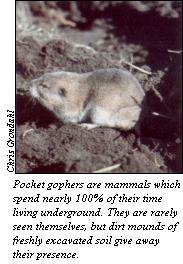
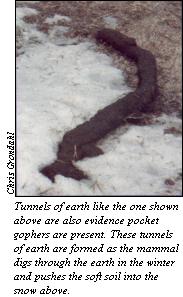 A mound of fresh, fine, black dirt above ground is a
sure sign that pocket gophers have been busy. These mammals,
slightly smaller than a prairie dog, live their lives entirely
underground excavating tunnels in search of food and living
quarters.
A mound of fresh, fine, black dirt above ground is a
sure sign that pocket gophers have been busy. These mammals,
slightly smaller than a prairie dog, live their lives entirely
underground excavating tunnels in search of food and living
quarters.
They can cause damage to garden vegetables and trees
by eating the roots from beneath the ground's surface. If you see
pocket gopher mounds in close proximity to young tree plantings or
gardens, you may eventually want to remove these animals.
Removal can be accomplished by purchasing small,
inexpensive traps which are placed within the animal's tunnel
system. Traps can be purchased from local farm stores or by ordering
from gardening magazines.
Begin by excavating away the fine, black dirt from
the original dirt mound above ground. Dig down until you find the
tunnel holes coming in from each side. It's best to put a trap in
both tunnels because its hard to say which way the animal will be
coming. After the traps have been set, cover the excavated opening
with a piece of plywood to create a dark environment. Place a weight
on top of the plywood to keep it in place.
Another control measure involves the use of a
commercially sold rodenticide which is put into the same tunnels
described above. This method involves the use of a cane which
deposits tablets underneath the soil surface. Trapping is safer,
however, and should be used when possible.
SKUNKS
The striped skunk is primarily a nocturnal animal
which makes its home in junk piles, old farm machinery, or building
foundations. It is attracted to areas by good populations of small
rodents or to areas where garbage has not been properly disposed.
Often, skunks will fall into window wells after
investigating around house foundations at night. Let the skunk find
its own way out by providing a "ladder" made of a long piece of
plywood covered with carpet. After placing one end of the plywood
into the bottom of the window well, move away and let nature take
care of the rest.
If you believe a skunk has taken residence
underneath your porch, foundation or mobile home, first find its
entrance. During the day, investigate possible entry locations. When
found, use bread flour spread on the ground near the entrance to
determine when the skunk leaves your home. After the skunk has
departed at night to feed seal the opening. After several days, the
skunk will move on.
If the skunk does not move on and problems persist,
traps can be used to capture skunks but the possibility of being
sprayed always exists. Skunks are not classified as game animals and
therefore can also be dispatched out of city limits without any
special licenses. If you see a skunk outside during the day acting
strange, take precautions and notify authorities as this animal may
be rabid.
RACCOONS
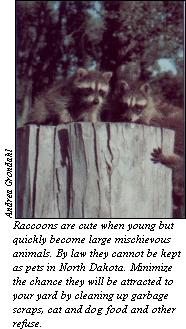 Raccoons can be clever animals while searching for food.
They can destroy gardens quickly and are especially fond of a sweet
corn patch. They will also come into a porch or garage for cat or
dog food and will continue to do so for as long as the opportunity
is provided. Overturned garbage cans or refuse scattered about your
yard is also a sign that a "coon" may be working the area.
Raccoons can be clever animals while searching for food.
They can destroy gardens quickly and are especially fond of a sweet
corn patch. They will also come into a porch or garage for cat or
dog food and will continue to do so for as long as the opportunity
is provided. Overturned garbage cans or refuse scattered about your
yard is also a sign that a "coon" may be working the area.
The best way to deter raccoons from an area is not
providing them a reason to feed. Keep pet food inaccessible and the
yard free of any scraps of garbage. If a garden is getting
destroyed, the best defense is a chicken wire type fence with a
strand or two of electric wire on top. Raccoons are excellent
climbers and fences alone will be of little merit in preventing
entry.
Raccoons can be live trapped and transferred to a
new location. They are classified as furbearers and normally a
license is required to hunt or trap them. This law does not apply to
landowners, who may dispatch them on their own property
Sometimes, young or orphaned raccoons are picked up
by people who want to raise these cute, furry little creatures. This
is often the case when the mother coon has been destroyed by the
landowner.
Raising raccoons is illegal under a law by the State
Board of Animal Health. Young raccoons soon become large and lose
their cuteness. They can carry a number of diseases transmittable to
humans and have no training to survive in the wild after being hand
raised. It is best to totally avoid this situation.
DEER
Deer are popular with many people, especially those
living on the fringes of town or in the country. Many of the deer
problems encountered can be traced to artificial feeding. Feeding
deer is done with good intentions but usually leads to other damages
that often are intolerable. Deer and other large species not only
feed on the corn or other grain you provide but move to fruit trees,
gardens, and flower beds. This can pose a problem to neighbors once
deer are attracted to an area.
Health risks are also increased for deer who are
artificially congregated into a small area. Diseases carried by a
deer are easily transmitted by the close contact made at the feeding
station. Naturally, deer browse far apart from one another on buds
from trees and other plants.
The best defense against deer damage is planting
species of trees, shrubs and flowers that deer do not prefer.
Appendix
D lists the trees, shrubs and other plants
that deer prefer, sometimes eat, and generally dislike.
When plants that deer like to eat are planted, they
must be protected by fencing. The best method is a six to eight-foot
high mesh fence. Deer will simply jump over lower fences, especially
if they are hungry and one of their favorite plants is the target.
CATS
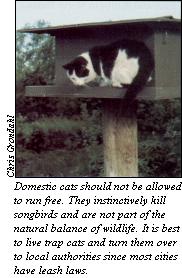 House cats and feral (wild)cats have a significant
impact upon wild songbirds. A conservative estimate puts the cat
population at about 55 million in the United States. If 80 percent
of those cats were either feral or cats that were allowed to go
outside, and if only one cat in ten caught one bird per day, 4.4
million birds would be killed per day by cats. Cats are not a
natural part of the food chain and detrimental to songbird
populations.
House cats and feral (wild)cats have a significant
impact upon wild songbirds. A conservative estimate puts the cat
population at about 55 million in the United States. If 80 percent
of those cats were either feral or cats that were allowed to go
outside, and if only one cat in ten caught one bird per day, 4.4
million birds would be killed per day by cats. Cats are not a
natural part of the food chain and detrimental to songbird
populations.
If you own cats, keep them on a leash or indoors. At
the very minimum, keep them inside or under control when nesting
season and migrational periods are in full swing. The cat is not at
fault for instinctively hunting. The owner is at fault for letting
it do so.
Bird feeders should be placed where cats cannot get
to them, away from limbs or other platforms from where cats can
jump. If your neighbor's cats are in your yard, ask them nicely to
keep them under control. Repeated offenders can be live trapped and
turned over to city authorities as most urban areas have leash laws
for both dogs and cats.
INSECTS
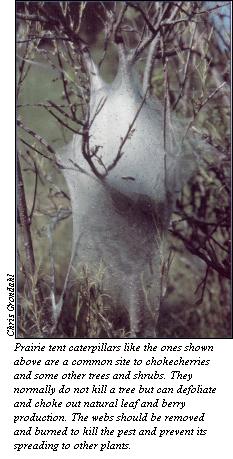





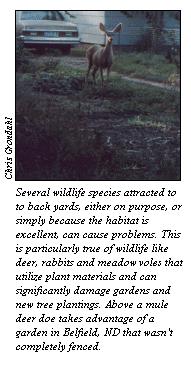
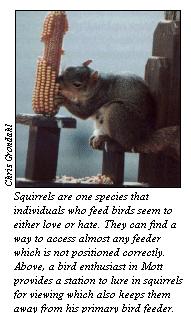 Squirrels, depending on who you ask, can either be
entertaining little friends or absolute pests. Mature city forests
and folks who feed birds have probably created better living
conditions for the squirrel than the squirrel can find in the wild.
For this reason, it has become one of the most talked about urban
wildlife species.
Squirrels, depending on who you ask, can either be
entertaining little friends or absolute pests. Mature city forests
and folks who feed birds have probably created better living
conditions for the squirrel than the squirrel can find in the wild.
For this reason, it has become one of the most talked about urban
wildlife species.
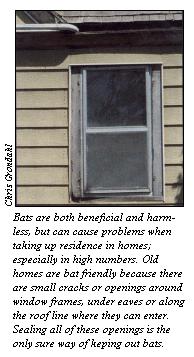 This small, flying mammal has been highly
persecuted in the past because of the misconceptions developed by
movies and those spreading rumors and personal fears. In reality,
bats are one of the most beneficial sources of insect control in the
world. Bats can each consume half their weight in insects each
night. They are no more likely to carry rabies than any other mammal
and have a sonar system more sophisticated than technology developed
for fighter aircraft and smart bombs.
This small, flying mammal has been highly
persecuted in the past because of the misconceptions developed by
movies and those spreading rumors and personal fears. In reality,
bats are one of the most beneficial sources of insect control in the
world. Bats can each consume half their weight in insects each
night. They are no more likely to carry rabies than any other mammal
and have a sonar system more sophisticated than technology developed
for fighter aircraft and smart bombs.
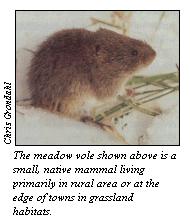 Beside the common house mouse found inside human
dwellings, there are native small mammals which live in grassland
and woodland habitats near houses. These small mammals have natural
predators such as bull snakes, hawks and owls which are probably the
best defense against them.
Beside the common house mouse found inside human
dwellings, there are native small mammals which live in grassland
and woodland habitats near houses. These small mammals have natural
predators such as bull snakes, hawks and owls which are probably the
best defense against them.
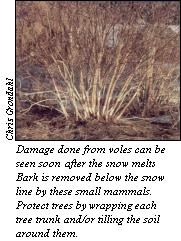 Keep inside areas as neat and tidy as
possible. Use control measures such as traps or chemical means when
all else fails.
Keep inside areas as neat and tidy as
possible. Use control measures such as traps or chemical means when
all else fails.
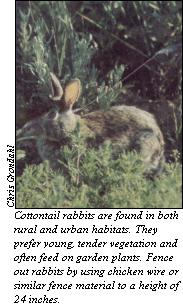 Cottontail rabbits are frequently found in urban areas
where they enjoy eating garden plants and flowers. During the
winter, they will both girdle bark from trees and also eat tops of
young trees within their reach. Protect gardens, trees and other
plants by enclosing in wire fence material with a mesh size smaller
than two and one- half inches.
Cottontail rabbits are frequently found in urban areas
where they enjoy eating garden plants and flowers. During the
winter, they will both girdle bark from trees and also eat tops of
young trees within their reach. Protect gardens, trees and other
plants by enclosing in wire fence material with a mesh size smaller
than two and one- half inches.

 A mound of fresh, fine, black dirt above ground is a
sure sign that pocket gophers have been busy. These mammals,
slightly smaller than a prairie dog, live their lives entirely
underground excavating tunnels in search of food and living
quarters.
A mound of fresh, fine, black dirt above ground is a
sure sign that pocket gophers have been busy. These mammals,
slightly smaller than a prairie dog, live their lives entirely
underground excavating tunnels in search of food and living
quarters.
 Raccoons can be clever animals while searching for food.
They can destroy gardens quickly and are especially fond of a sweet
corn patch. They will also come into a porch or garage for cat or
dog food and will continue to do so for as long as the opportunity
is provided. Overturned garbage cans or refuse scattered about your
yard is also a sign that a "coon" may be working the area.
Raccoons can be clever animals while searching for food.
They can destroy gardens quickly and are especially fond of a sweet
corn patch. They will also come into a porch or garage for cat or
dog food and will continue to do so for as long as the opportunity
is provided. Overturned garbage cans or refuse scattered about your
yard is also a sign that a "coon" may be working the area.
 House cats and feral (wild)cats have a significant
impact upon wild songbirds. A conservative estimate puts the cat
population at about 55 million in the United States. If 80 percent
of those cats were either feral or cats that were allowed to go
outside, and if only one cat in ten caught one bird per day, 4.4
million birds would be killed per day by cats. Cats are not a
natural part of the food chain and detrimental to songbird
populations.
House cats and feral (wild)cats have a significant
impact upon wild songbirds. A conservative estimate puts the cat
population at about 55 million in the United States. If 80 percent
of those cats were either feral or cats that were allowed to go
outside, and if only one cat in ten caught one bird per day, 4.4
million birds would be killed per day by cats. Cats are not a
natural part of the food chain and detrimental to songbird
populations.





 1999 -
1999 -